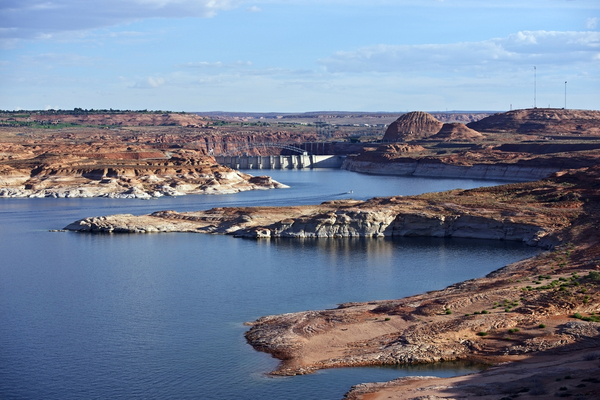Lake Powell, the nation’s second-largest reservoir and one that provides water and power to millions of people in southern California, has reached its lowest levels since its first filling in the 1960s, and its companion reservoir, Lake Mead, is at levels almost as low.
As USA Today reports, these two reservoirs alone, fed by the mighty Colorado River, provide the water that more than 40 million Americans depend on. Despite the storms that brought heavy rain and snow to California and other Western states in January, experts say it would take years of such weather to replenish the West’s water resources.
“In the year 2000, the two reservoirs were 95% full. They’re roughly 25% full now,” said Brad Udall, a water and climate scientist at Colorado State University. “It’s hard to overstate how important the Colorado River is to the entire American southwest.”
The most recent readings show that the lake fell to 3,522.16 feet above sea level, just below the previous record low set in April 2022. The reservoir is currently about 22% full, and is expected to keep declining until around May, when mountain snowmelt rushes into the streams that flow into the lake.
Although the spring is forecast to bring levels up somewhat, and even though strong snow and heavy rains have blanketed the West this winter, climate scientists say that one wet year won’t be nearly enough to substantially boost Lake Powell in the face of a 23-year megadrought.
The water in Lake Powell is low because the amount of water in the Colorado River has been falling for decades. At the same time, demand has risen due to increased population growth in the West. Overall, the river’s flow is down 20% in this century relative to the 20th century.
Those dropping water levels have spawned a crisis for the Bureau of Reclamation, the federal agency that manages the West’s largest dams, including Glen Canyon Dam and the hydroelectric turbines within that generate power for 5 million people across seven states.
At 3,490 feet, the “minimum power pool” level, the bureau may be unable to generate hydropower from the dam. At 3,370 feet, the reservoir hits “dead pool,” at which point water is no longer able to pass through the dam through gravity.
If the lake falls another 32 feet – about the amount it fell in the past year – power generation concerns become more urgent. “That’s a doomsday scenario,” said Bill Hasencamp, Colorado River resources manager for the Metropolitan Water District of Southern California. Before things get to that point the Department of the Interior will require reductions in use. this spring is forecast to bring levels up somewhat.
More than four scientific studies have pinned a large part of the decline on human climate change. It’s partly that there’s less rain and snow, partly that as temperatures rise, plants use more water and more water evaporates out of the soil which would otherwise have ended up in the river. In addition, the river itself experiences more evaporation.
“It’s unfortunate that the largely natural occurrence of a drought has coincided with this increasing warming due to greenhouse gases,” said Flavio Lehner, a professor of atmospheric sciences at Cornell University. “That has brought everything to a head much earlier than people thought it would.”
As for Lake Mead, it is the nation’s largest reservoir, a companion to Lake Powell. Mead was created when the Hoover Dam was completed in 1935. It supplies water and power to Arizona, California, New Mexico and Mexico.
The situation at Lake Mead isn’t much better than Lake Powell, its current level is 1,047 feet above sea level. You would have to go back to April of 1937, also two years into its initial filling, to find levels that low. It is forecast to have a new record low next summer, said Hasencamp.
The lake isn’t low enough yet to cause concerns about getting water out, but any hope of it refilling is years away, if ever, due to lowered rain and snow and increasing evaporation. Some of America’s largest cities depend on the water from Lake Mead. “It’s 90% of the water supply to Las Vegas, 50% to Phoenix, effectively 100% to Tucson and 25% to Los Angeles,” said Udall.
The Department of the Interior had asked the seven states of the Colorado River Compact to come up with a plan to cut between 2 and 4 million acre-feet of water by January, but they haven’t been able to come up with an agreement.
Because of that, it’s expected that the Department of the Interior’s Bureau of Reclamation, which oversees water management, will mandate one sometime next year. “This is apparently a decent (water) year, but still, if it turns dry again there are some pretty big reductions on tap and every state could be affected,” said Hasencamp.
It will be painful but it doesn’t mean the area can’t thrive. “The West might look different,” said Hasencamp. “You might not see the lush lawns of today and endless fields of alfalfa, but you will see thriving communities and agricultural regions.”
—
Photo Credit: Virrage Images / Shutterstock.com
